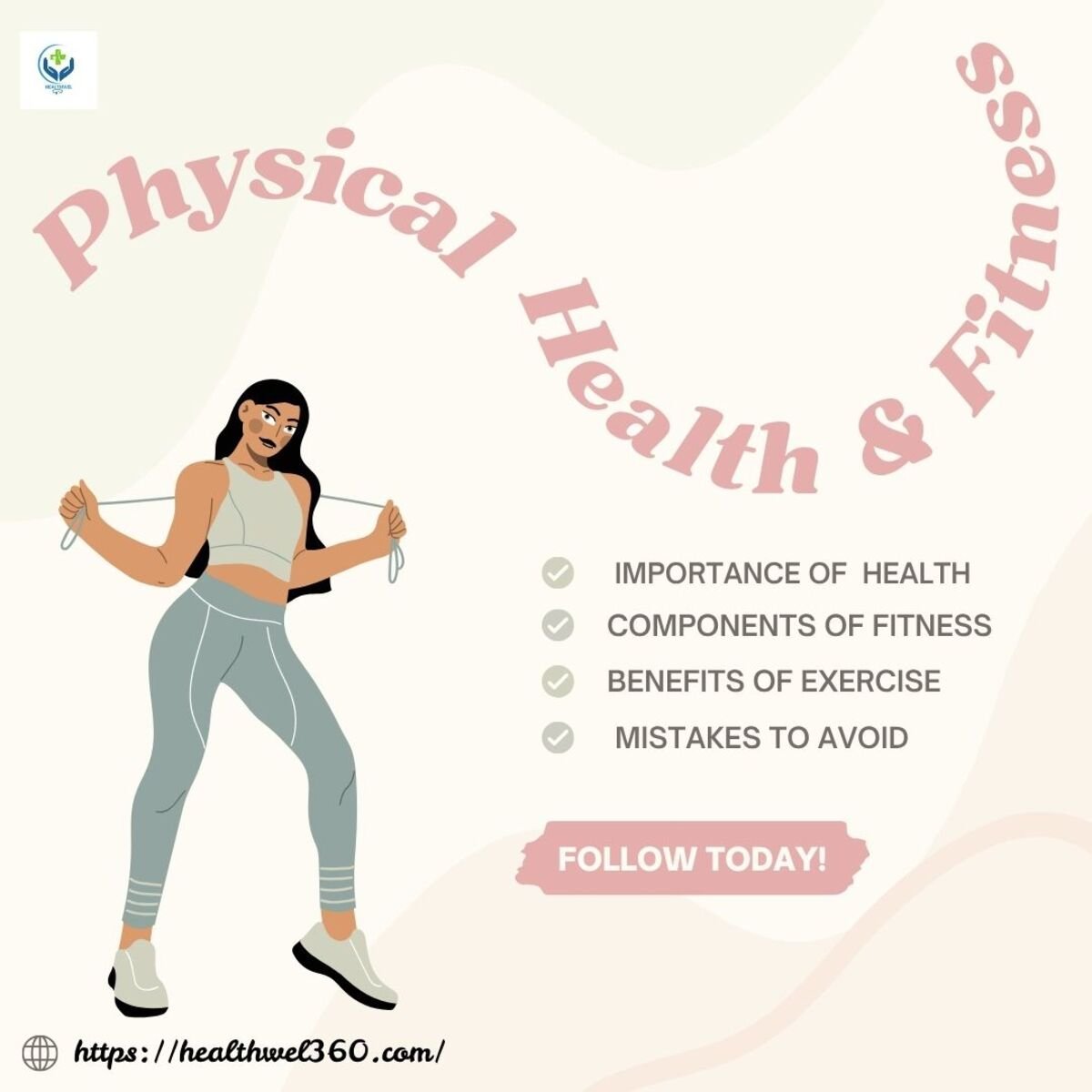Physical Health & Fitness: Ultimate Guide to a Healthier Lifestyle. In today’s fast-paced world, maintaining good physical health and fitness is more important than ever. With sedentary lifestyles, processed foods, and increasing stress levels, many people struggle to stay active and healthy. This comprehensive guide covers everything you need to know about physical health and fitness, including:
- The Importance of Physical Health & Fitness
- Key Components of Fitness
- Benefits of Regular Exercise
- Nutrition for Optimal Fitness
- Common Fitness Mistakes to Avoid
- Creating a Sustainable Fitness Routine
- Mental Health and Physical Fitness Connection
- Staying Motivated on Your Fitness Journey
By the end of this article, you’ll have a clear understanding of how to improve your physical health and maintain a fit lifestyle.
- The Importance of Physical Health & Fitness
For a healthy and happy lifestyle, physical fitness is essential. A strong, healthy body improves:
- Longevity – Reduces the risk of chronic diseases like heart disease, diabetes, and obesity.
- Energy Levels – Regular physical activity boosts stamina and reduces fatigue.
- Immune Function – A fit body is better at fighting infections and illnesses.
- The quality of Life: Promotes independence, flexibility, and mobility as you age.
Without regular exercise and proper nutrition, the body becomes more susceptible to health problems. The World Health Organization (WHO) recommends at least 150 minutes of moderate-intensity exercise per week for adults.
- Key Components of Fitness
Fitness is not just about lifting weights or running—it’s a combination of several components:
Cardiovascular Endurance
This describes a capacity of both the lungs and the heart to provide oxygen during prolonged physical exertion. Examples:
- Running
- Cycling
- Swimming
- Jump rope
Muscular Strength
The amount of force a muscle can exert. Strength training helps build lean muscle mass. Examples:
- Weightlifting
- Resistance band exercises
- Bodyweight exercises (push-ups, pull-ups)
Muscular Endurance
The ability of muscles to perform repetitive movements without fatigue. Examples:
- High-repetition weight training
- Planks
- Circuit training
Flexibility
The range of motion around a joint. Increased flexibility reduces the risk of injury and improves performance. Examples:
- Yoga
- Dynamic and static stretching
- Pilates
Body Composition
The ratio of fat to muscle in the body. A good physical composition lowers disease risk.
Balancing these components ensures a well-rounded fitness routine.
The advantages of staying active go beyond just looking good. Here’s how regular exercise benefits you:
Weight Management
Workout helps you burn calories while keeping an appropriate weight. Combining cardio and strength training maximizes fat loss while preserving muscle.
Stronger Heart & Lungs
Cardiovascular exercise improves circulation, lowers blood pressure, and reduces heart disease risk.
Improved Mental Health
Endorphins, which are released during physical activity, help to alleviate stress and anxiety.
It also enhances cognitive function and memory.
Better Sleep
Regular exercise helps regulate sleep patterns, leading to deeper, more restful sleep.
Increased Energy
Exercise boosts mitochondrial function (energy production in cells), making you feel more energetic throughout the day.
Stronger Bones & Joints
The use of weight workouts (walking, resistance training) enhances bone density and help prevent osteoporosis.
Enhanced Immune System
Moderate exercise strengthens immunity, reducing the frequency of illnesses.
- Nutrition for Optimal Fitness
Exercise alone isn’t enough—proper nutrition fuels performance and recovery.
Macronutrients
- Proteins – Essential for muscle repair (chicken, fish, beans, tofu).
- Fats – Support hormone function (avocados, nuts, olive oil).
Micronutrients
Vitamins (A, C, D, E, K) and minerals (iron, calcium, magnesium) are crucial for metabolic functions.
Hydration
Water regulates body temperature, lubricates joints, and aids digestion. Aim for at least 2-3 Liters per day.
Pre- & Post-Workout Nutrition
- Before Exercise – Carbs + protein (banana with peanut butter).
- After Exercise – Protein + carbs (chicken with quinoa).
- Avoid Processed Foods & Sugars
These cause energy crashes and inflammation, hindering fitness progress.
Despite their excellent motives, lots of individuals make blunders that slow progress:
Skipping Warm-Ups & Cool-Downs
Increases injury risk and reduces flexibility.
Overtraining
Leads to burnout, injuries, and weakened immunity. Rest days are essential.
Poor Form
Incorrect technique causes injuries. Always prioritize form over weight.
Neglecting Recovery
Muscles grow during rest. Sleep is expanding, and rolling in foam can help you recuperate.
Focusing Only on Cardio or Only on Weights
A combination of exercises (power, activity and flexible) produces the best results.
- Creating a Sustainable Fitness Routine
Consistency is key. Follow these steps:
Set Realistic Goals
- SMART objectives (unique, attainable, quantifiable, relevant, and time-bound).
- Example: “Lose 5 pounds in 2 months” instead of “Get fit”.
Choose Activities You Enjoy
- If you hate running, try dancing or swimming.
C.Schedule Workouts
- Treat exercise like an important appointment.
Track Progress
- Use an app for fitness or notebook to track progress.
Mix It Up
- Avoid dullness by switching between aerobic, power, and adaptability exercises.
- Mental Health and Physical Fitness Connection
The mind and body are deeply connected:
- Exercise Reduces Stress – Lowers cortisol (stress hormone) levels.
- Boosts Confidence – Achieving fitness goals improves self-esteem.
- Helps with Depression & Anxiety – Acts as a natural antidepressant.
Mindfulness practices like yoga and meditation further strengthen this connection.
- Staying Motivated on Your Fitness Journey
Motivation fluctuates, but discipline keeps you going:
Find a Workout Buddy
Accountability increases consistency.
Broward Yourself
Celebrate milestones (e.g., new workout gear after a month of consistency).
Visualize Success
Imagine how you’ll feel and look by sticking to your plan.
Join a community
Fitness groups or online forums provide support.
Focus on How Exercise Makes You Feel
Energy, confidence, and mood improvements are powerful motivators.
Conclusion
Physical health and fitness are lifelong commitments that pay off in countless ways. By understanding the key components of fitness, eating right, avoiding common mistakes, and staying motivated, you can build a sustainable routine that enhances both body and mind.
